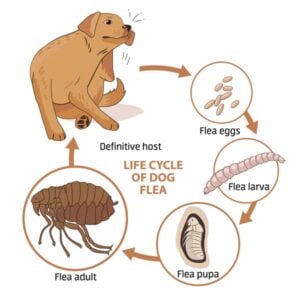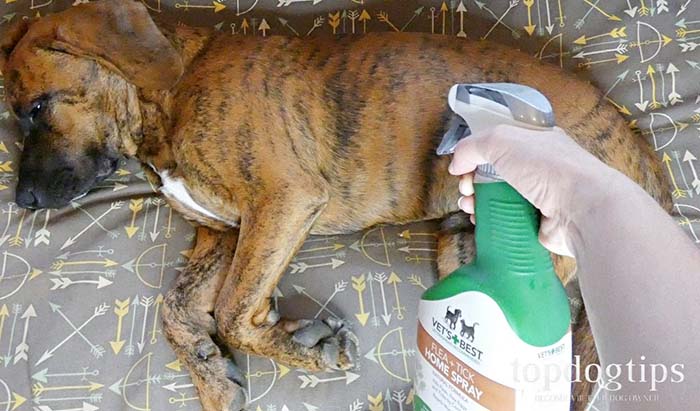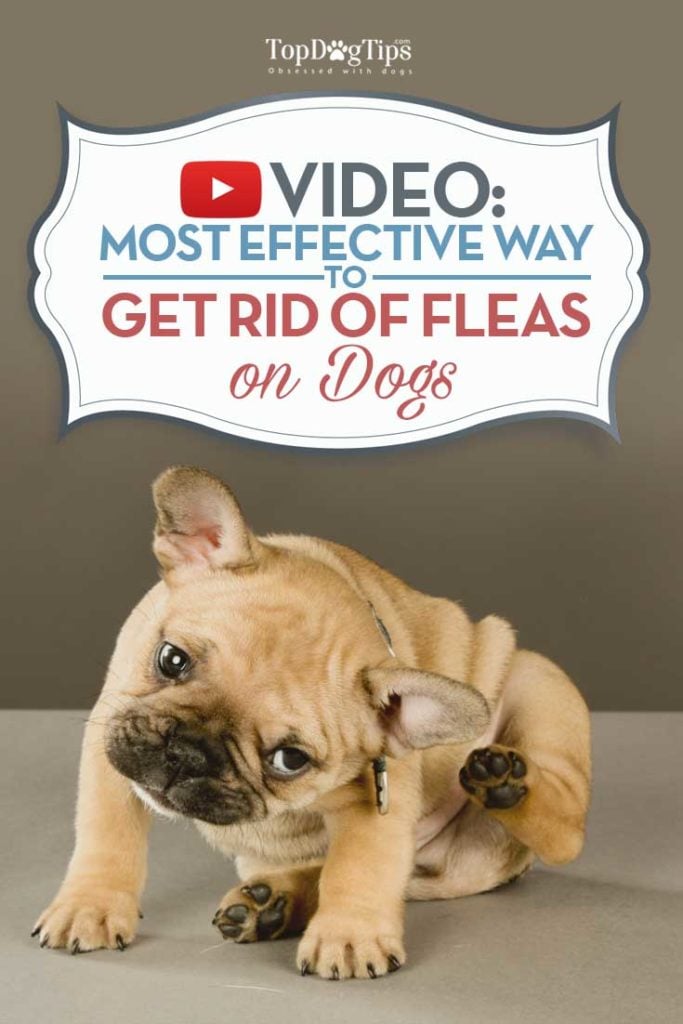Table of Contents
There are more than 2,000 different species of fleas.
These parasites do best in warm and humid environments, and they feed off the blood of a host animal.
Dogs are an ideal host for these pests, which is why dog owners must know how to remove fleas from a dog and be prepared for it.
Dealing with Fleas at Home
First, it's important for you to understand how fleas survive and procreate. During its life cycle, a flea changes from an egg to a larva, to the pup, and finally to an adult flea.
An adult female flea can live for more than three weeks and lay 20-30 eggs each day. Fleas can survive for more than 100 days without a blood meal.
 Dogs aren't the only hosts for fleas – people and other pets in the household are also at risk. If you've come in contact with fleas before, they may have infested your house, and that would require a whole other procedure.
Dogs aren't the only hosts for fleas – people and other pets in the household are also at risk. If you've come in contact with fleas before, they may have infested your house, and that would require a whole other procedure.
Even though most fleas will usually live on dogs, they drop onto furniture, carpeting, and upholstery as your dog goes about his daily routine.
If your dog had or has fleas, it's almost guaranteed they are in your home too. So even if you got rid of fleas on your dog, you're not necessarily in the green zone yet.
You should check your dog for fleas at least twice a week.
Early detection is key to getting rid of fleas quickly and easily.
The most effective way is by using preventative flea treatments which will keep your dog from contracting these pests in the first place.
The best preventative flea solutions are flea collars and flea pills.
These have been shown in studies to be the most effective way of preventing and killing fleas on dogs and cats.
There are also natural remedies for fleas; however, while they're less harmful to use, they aren't as effective as commercial products.
For home flea infestations, there are separate solutions like flea bombs, which we'll talk about below.
How to Remove Fleas From a Dog
1. Dog Flea Prevention
The best thing you can do is try to prevent a flea infestation in the first place.
There are many commercial products available to help you with this and a few natural remedies that some owners swear by, but the level of efficacy varies greatly.
Flea collars and topical flea treatments are the most popular. Flea collars and topical treatments are almost 100% guaranteed to keep fleas off a dog.
Studies have shown them to be safe to use with dogs, but their biggest con is the price – they're expensive.
You can also use edible flea pills. They are more convenient than dog flea collars or topical treatments, but they are also costly and aren't suitable for every dog.
Some consumers also question the safety of these pills, but we have yet to see any studies.
Some of the best dog flea prevention products currently are these:
| Preview | Product | Rating | |
|---|---|---|---|

|
FRONTLINE Plus Flea and Tick Treatment for Medium... | 20,884 Reviews | Check Price |

|
Seresto Large Dog Vet-Recommended Flea & Tick... | 99,024 Reviews | Check Price |

|
Advantus Dog Advantus Chewable Flea Treatment for... | 4,037 Reviews | Check Price |
2. Natural Way of Preventing Fleas on a Dog
There are several homeopathic or natural solutions that may or may not help with flea prevention.
There are no studies to prove either way, but some anecdotal evidence from pet owners claims that these products are effective to a degree. Below are a few options.
Natural flea solution. Add 1 teaspoon of apple cider vinegar to your pet's water bowl each day. It has been said to keep fleas from infesting dogs.
This is the option that I myself sometimes use, because apple cider vinegar also aids in a healthy skin and coat.
Natural dog flea shampoo. These types of natural flea shampoos don't necessarily prevent your dog from attracting the parasite, but they do help to deal with them slightly after infestation.
I've written a guide on how to make a homemade flea shampoo.
Anti-flea essential oils. Some claim that essential oils may also prevent fleas from jumping on your dog and they also smell better than the above natural solution.
They need to be mixed with carrier oil, so research it before making your own dog flea spray. Popular essential oils that repel fleas from dogs include:
Lavender, Peppermint, Lemon, Cedar, Clary sage, and Eucalyptus.
3. How to Remove Fleas On a Dog
If your dog does happen to get fleas, you've only got one choice. You need to be consistent and diligent with your dog's flea treatment. You also need to act fast.
There are several products you can try to remove fleas from a dog quickly.
After you've seen a flea, waiting just one day could add hundreds of fleas to the population in your home. You'll need to treat your dog as soon as you spot the first flea.
Shampoos. You need to have a flea shampoo on hand and give your dog a flea bath, then let the shampoo sit in your dog's coat for 10 minutes. Some medicated shampoos can also be very effective for serious flea infestations on a dog.
Sprays. As you can see in my picture above, you can also use a dog flea spray which is made to be used on pets or in your home and on your furniture. Most dog flea sprays are safe to use on pets.
Note: Whether you choose a dog flea shampoo or spray, follow the instructions on the packaging. Some products need to sit in the dog's coat for a specific amount of time to be effective. If you rinse them off early, the fleas are likely to survive.
Select a flea product that is safe for your pet. Look for as may natural ingredients as possible, and make sure that they don't include any toxic to dogs chemicals on the list.
4. Removing Fleas From Your Home
When it comes to how to get rid of fleas on a dog, consider the environment that your pet lives in. There are many ways to remove fleas from your home, but none of them are effective enough on their own (yes, I've tried).
Vacuums. Your first best defense against fleas in the house is a vacuum cleaner. Unlike some flea treatments, a vacuum will get rid of a flea at any stage of its life cycle.
Many flea sprays only kill adult fleas, but a good vacuum will suck up eggs as well as adults.
Note: After you've finished vacuuming, dispose of the contents (whether it's a bag or a canister) in an outdoor trash receptacle as soon as possible.
Sprays/Powders. The next step right after you've vacuumed your house is to go through it using either a flea carpet spray or flea powder.
Another option for treating fleas that recently has become popular but is less effective are flea traps, including electric ones.
These traps can be used indefinitely, and you can place them around the house after you've done the full-on home flea treatment.
Washing. You'll also need to wash all the bedding (human and animal) in your home. Any area that your dog sleeps in or comes in contact with will need to be thoroughly cleaned.
Treat your dog's house, crate, and wash the bed, whether it's indoors or outdoors.
5. Flea Bomb Your House
No, not that type of bombing. And this wouldn't be a good article on how to remove fleas from a dog if I didn't mention flea bombs (or flea foggers), one of the most popular methods out there.
Flea bombs are designed to control heavy infestation of fleas and other similar parasites in your house.
They are extremely effective because, unlike sprays or other treatments, flea bombs contain chemicals that will be sprayed into the air as soon as you press the release button.
You can purchase flea bombs in almost any store including department stores, hardware stores, pet stores or just on Amazon.
The fog released by these products will get into every nook and cranny of your home to kill fleas in any stage of life, including flea eggs, with nothing else left in your home to procreate; there will be no future fleas.
Some of the best flea bomb manufacturers on the market today are these:
| Preview | Product | Rating | |
|---|---|---|---|

|
Hot Shot No Mess! Fogger With Odor Neutralizer,... | 13,449 Reviews | Check Price |

|
Advantage Flea and Tick Household Fogger For... | 2,172 Reviews | Check Price |

|
Black Flag Indoor Fogger, Pack of 6 | 4,829 Reviews | Check Price |
Warning: You have to be very careful when using flea bombs in your home. If you do not follow the instructions indicated on the package, you risk poisoning yourself, other people and pets in your household.
READ NEXT: What Do Dog Fleas Look Like?
Disclosure: We may earn affiliate commissions at no cost to you from the links on this page. This did not affect our assessment of products. Read more here and find full disclosure here.
Want to share this?
















